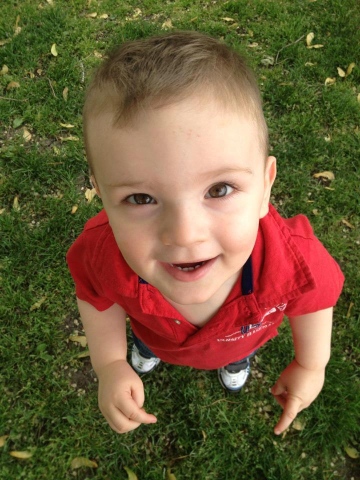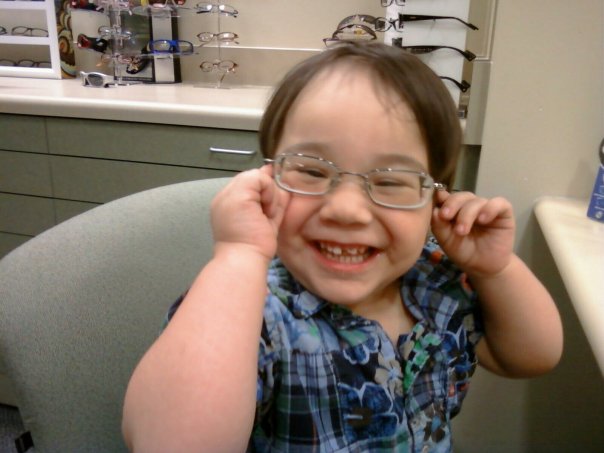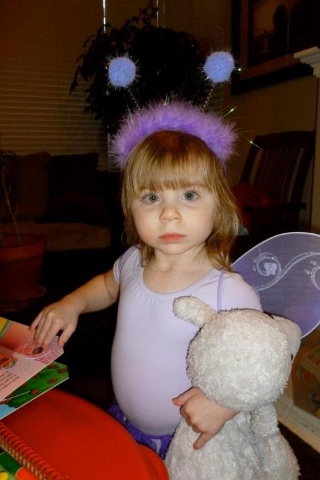"The MAGIC Foundation has been a lifeline to help understand my daughter's Optic Nerve Hypoplasia diagnosis. As a family, we have been richly blessed to experience their conventions and fundraisers. Overall, The MAGIC Foundation has been instrumental in educating our family and build life long friendships with other MAGIC families." Nancy A., Bastrop, TX
 A child with the Syndrome of Optic Nerve Hypoplasia (ONH), also known as Septo Optic Dysplasia (SOD) or DeMorsiers Syndrome, has under-developed optic nerves. The optic nerves carry messages from the eye to the brain. ONH is the single leading cause of blindness in infants and toddlers. It remains unclear why ONH occurs, however with early intervention, many of the problems associated with Optic Nerve Hypoplasia or Septo Optic Dysplasia can be improved.
A child with the Syndrome of Optic Nerve Hypoplasia (ONH), also known as Septo Optic Dysplasia (SOD) or DeMorsiers Syndrome, has under-developed optic nerves. The optic nerves carry messages from the eye to the brain. ONH is the single leading cause of blindness in infants and toddlers. It remains unclear why ONH occurs, however with early intervention, many of the problems associated with Optic Nerve Hypoplasia or Septo Optic Dysplasia can be improved.
A child with Optic Nerve Hypoplasia has optic nerves that are underdeveloped. This commonly occurs in both eyes, often with one eye worse than the other, bit it can also occur in only one eye. Instead of having over one million connections from each eye to the brain, people with Optic Nerve Hypoplasia have far fewer connections. The more connections there are between the eye and the brain, the better the vision. Some people with Optic Nerve Hypoplasia have near normal vision in one eye, others have decreased vision in both eyes, and others are completely blind. Many children with Optic Nerve Hypoplasia experience some improvement in their vision over the first few years of life.
Children with the syndrome of Optic Nerve Hypoplasia may also have developmental delay, abnormalities in how the brain is formed (brain structure) and how the brain works (brain function), and problems in the hypothalamic-pituitary axis, a portion of the brain involved in the endocrine system. All problems with the brain can range from mild to very serious.
Diagnosis
 An eye doctor can diagnose ONH by looking inside the eye with an ophthalmoscope. The front surface of the optic nerve (optic disc) appears smaller than normal. The ophthalmologist may want to take pictures (fundus photos) of the optic disc to document the size. Most people with ONH have nystagmus. Nystagmus is characterized by unusual eye movements where the eyes may seem to move around with no real pattern or purpose. This occurs because the eyes are not able to focus well enough to hold still. Misalignment of the eyes, known as strabismus, may also occur.
An eye doctor can diagnose ONH by looking inside the eye with an ophthalmoscope. The front surface of the optic nerve (optic disc) appears smaller than normal. The ophthalmologist may want to take pictures (fundus photos) of the optic disc to document the size. Most people with ONH have nystagmus. Nystagmus is characterized by unusual eye movements where the eyes may seem to move around with no real pattern or purpose. This occurs because the eyes are not able to focus well enough to hold still. Misalignment of the eyes, known as strabismus, may also occur.
When a child is diagnosed with ONH, he or she will undergo an MRI (magnetic resonance imaging) study to determine if there are major problems with the brain structure. Abnormalities in brain structure seen on neuro-imaging may help a doctor to predict the child’s prognosis. However, it is important to note that even when brain anomalies are not present, problems with the endocrine system still occur in about 70% of cases.
At the time of diagnosis, the child will also undergo endocrinologic studies. These tests will show the levels of various hormones in the body that are crucial to development of the child. In ONH, many of these hormones may not be adequately produced. The most common problem with the endocrine system is growth hormone deficiency.
Intervention
When a child is less than 3-4 years of age, it is often difficult to predict the future development such as speech, intelligence and learning. Even as children get older, it is sometimes difficult to assess the brain function and overall development of a child with poor vision. This means that it is important to monitor the child’s growth and development often.
Be sure that your child is tested and treated by professionals who have experience working with children with vision impairment. Testing to determine how your child is developing and implementation of early intervention programs are best done by a multidisciplinary team that may include: pediatricians, psychologists, occupational therapists, speech therapists, physical therapists and teachers of the visually impaired. Testing can be done in several different settings including your own home, schools, hospitals or other clinical settings.
Pituitary Dysfunction
 The pituitary gland is found at the base of the brain and serves as the body’s “master control gland” because it makes important chemicals (hormones) and controls the production of hormones in glands located in the other parts of the body. These hormones are required for growth energy control (metabolism) and sexual development. When a child has problems making hormones in the pituitary gland it is called hypopituitarism. Your child will be tested to see if there are any problems making hormones. A child who initially does not have hormone problems may develop them at a later time. Therefore, it is very important for your child to be tested regularly as he or she grows up. A recent study showed that endocrine problems occurred in around 70% of cases of ONH.
The pituitary gland is found at the base of the brain and serves as the body’s “master control gland” because it makes important chemicals (hormones) and controls the production of hormones in glands located in the other parts of the body. These hormones are required for growth energy control (metabolism) and sexual development. When a child has problems making hormones in the pituitary gland it is called hypopituitarism. Your child will be tested to see if there are any problems making hormones. A child who initially does not have hormone problems may develop them at a later time. Therefore, it is very important for your child to be tested regularly as he or she grows up. A recent study showed that endocrine problems occurred in around 70% of cases of ONH.
Growth hormone deficiency is the most common hormone problem of in ONH. This deficiency occurred in 64% of cases. Lack of growth hormone usually causes a child to grow at a slower rate than normal; however normal growth has occurred in some cases. Some children who lack growth hormone also have low blood sugar. Without treatment, your child will be shorter than expected when growth is finished. With proper treatment you can expect your child’s growth to be close to what it would have been without a growth hormone problem.
Cortisol is made by the two adrenal glands that are located on top of both of the kidneys. Around 17% of patients with ONH have adrenal gland insufficiency. A hormone from the pituitary gland (ACTH) signals the adrenal gland to make small amounts of cortisol at various times during the day. Cortisol is also made during times of physical stress (such as during surgery, when suffering from an illness or injury, or when the body is dehydrated). The extra cortisol is necessary to help the body continue to create energy, control the blood sugar and allow for proper heart and lung function. If your child’s cortisol level is found to be low, some children will need special tests called cortisol stimulation tests to find out if they make some cortisol or if they are not able to make any cortisol. If cortisol production is low, your child may need to take a cortisol replacement medication. Additional cortisol might also be necessary during times of physical stress. If your child has problems with cortisol, you should get additional information about caring for a child with this problem.
Thyroid hormone is made by the thyroid gland in the neck. A poorly functioning pituitary gland leads to deficiency in thyroid hormone (hypothyroid) in around 40% of ONH patients. Thyroid hormone helps in normal growth and helps to make energy for the body to function. Lack of thyroid hormone can lead to poor growth, slowing of mental and muscle function, weight gain, feeling cold, irregular periods (menstrual cycle), hair loss, hoarse voice, brittle nails and dry coarse skin. In young children who are untreated, hypothyroidism may also result in developmental delay. Thyroid hormone levels (T4 and Free T4) in the blood should be checked when the diagnosis of ONH is made. If your child lacks thyroid hormone, he or she can easily be treated with thyroid pills. Careful monitoring of blood levels of T4 will be necessary to ensure maintenance of adequate levels. With proper treatment, your child’s thyroid problem will be corrected and side effects of low thyroid hormone avoided.
The pituitary produces a hormone called Anti-Diuretic Hormone (ADH) that is responsible for keeping water in the body by controlling the amount of urine that is created. Without enough ADH a person loses too much water from the body and becomes dehydrated. The person feels very thirsty, has a dry mouth and yet continues to make large amounts of urine. If the child cannot get enough fluid to replace what is being lost in the urine, this can lead to dehydration and a very high level of sodium in the body. This dehydration can cause serious problems. If this problem is suspected, your child may need to have blood and urine tests. Sometimes a special test called a water deprivation test needs to be done. This test lasts up to 8 hours and is done in the hospital or specially equipped office. Your child will not be able to have anything to drink for the entire test. Blood and urine tests are done to see if the proper amount of ADH is being created. If your child does not make enough ADH this is called Diabetes Insipidus (DI) or water diabetes. The most common treatment is a medicine called DDAVP. It can be given in the nose, by mouth or by injection.
Contributing Medical Specialists
Mark Borchert, M.D.
Associate Professor of Clinical Ophthalmology & Neurology
USC School of Medicine
Children’s Hospital of Los Angeles
Carrie Zaslow
Medical Student
Jefferson Medical College
Resources
» Download a printable version of the ONH brochure
» Click here for member benefits or to join The MAGIC Foundation
» "LIKE" The MAGIC Foundation's Facebook page
» Join our closed ONH/SOD Facebook group for parents. After you request to join, please message an admin to gain access or email Rachel at sod-onh@magicfoundation.org
» Would you like to speak to someone about ONH? If so, call The MAGIC Foundation at 800-3MAGIC3 or (630) 836-8200 or Email Us
For assistance outside North America, visit our International Coalition to see resources in your country